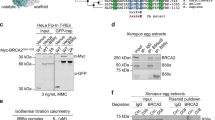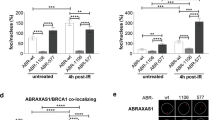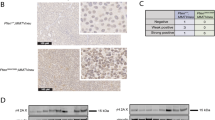Abstract
BRCA1 encodes a familial breast cancer suppressor that has a critical role in cellular responses to DNA damage1,2. Mouse cells deficient for Brca1 show genetic instability, defective G2–M checkpoint control and reduced homologous recombination3,4. BRCA1 also directly interacts with proteins of the DNA repair machinery5 and regulates expression of both the p21 and GADD45 genes6,7,8. However, it remains unclear how DNA damage signals are transmitted to modulate the repair function of BRCA1. Here we show that the BRCA1-associated protein CtIP9,10,11,12 becomes hyperphosphorylated and dissociated from BRCA1 upon ionizing radiation. This phosphorylation event requires the protein kinase (ATM) that is mutated in the disease ataxia telangiectasia13. ATM phosphorylates CtIP at serine residues 664 and 745, and mutation of these sites to alanine abrogates the dissociation of BRCA1 from CtIP, resulting in persistent repression of BRCA1-dependent induction of GADD45 upon ionizing radiation. We conclude that ATM, by phosphorylating CtIP upon ionizing radiation, may modulate BRCA1-mediated regulation of the DNA damage-response GADD45 gene, thus providing a potential link between ATM deficiency and breast cancer.
This is a preview of subscription content, access via your institution
Access options
Subscribe to this journal
Receive 51 print issues and online access
$199.00 per year
only $3.90 per issue
Buy this article
- Purchase on Springer Link
- Instant access to full article PDF
Prices may be subject to local taxes which are calculated during checkout





Similar content being viewed by others
References
Chen, Y., Lee, W. H. & Chew, H. K. Emerging roles of BRCA1 in transcriptional regulation and DNA repair. J. Cell. Physiol. 181, 385 –392 (1999).
Welcsh, P. L., Owens, K. N. & King, M. C. Insights into the functions of BRCA1 and BRCA2. Trends Genet. 16, 69–74 (2000).
Xu, X. et al. Centrosome amplification and a defective G2-M cell cycle checkpoint induce genetic instability in BRCA1 exon 11 isoform-deficient cells. Mol. Cell 3, 389–395 ( 1999).
Moynahan, M. E., Chiu, J. W., Koller, B. H. & Jasin, M. Brca1 controls homology-directed DNA repair. Mol. Cell 4, 511–518 (1999).
Zhong, Q. et al. Association of BRCA1 with the hRad50-hMre11-p95 complex and the DNA damage response. Science 285, 747– 750 (1999).
Ouchi, T., Monteiro, A. N. A., August, A., Aaronson, S. A. & Hanafusa, H. BRCA1 regulates p53-dependent gene expression. Proc. Natl Acad. Sci.USA 95, 2302–2306 (1998).
Somasundaram, K. et al. Arrest of the cell cycle by the tumour-suppressor BRCA1 requires the CDK-inhibitor p21WAF1/CiP1. Nature 389, 187–190 (1997).
Harkin, D. P. et al. Induction of GADD45 and JNK/SAPK-dependent apoptosis following inducible expression of BRCA1. Cell 97, 575–586 (1999).
Li, S. et al. Binding of CtIP to the BRCT repeats of BRCA1 involved in the transcription regulation of p21 Is disrupted upon DNA damage. J. Biol. Chem. 274, 11334–11338 ( 1999).
Wong, A. K. et al. Characterization of a carboxy-terminal BRCA1 interacting protein. Oncogene 17, 2279–2285 (1998).
Yu, X., Wu, L. C., Bowcock, A. M., Aronheim, A. & Baer, R. The C-terminal (BRCT) domains of BRCA1 interact in vivo with CtIP, a protein implicated in the CtBP pathway of transcriptional repression. J. Biol. Chem. 273, 25388– 25392 (1998).
Schaeper, U., Subramanian, T., Lim, L., Boyd, J. M. & Chinnadurai, G. Interaction between a cellular protein that binds to the C-terminal region of adenovirus E1A (CtBP) and a novel cellular protein is disrupted by E1A through a conserved PLDLS motif. J. Biol. Chem. 273, 8549–8552 ( 1998).
Shiloh, Y. Ataxia-telangiectasia and the Nijmegen breakage syndrome: related disorders but genes apart. Annu. Rev. Genet. 31, 635 –662 (1997).
Smith, G. C. & Jackson, S. P. The DNA-dependent protein kinase. Genes Dev. 13, 916–934 (1999).
Lees-Miller, S. P. et al. Absence of p350 subunit of DNA-activated protein kinase from a radiosensitive human cell line. Science 267, 1183–1185 (1995).
Ziv, Y. et al. Recombinant ATM protein complements the cellular A-T phenotype. Oncogene 15, 159–167 (1997).
Banin, S. et al. Enhanced phosphorylation of p53 by ATM in response to DNA damage. Science 281, 1674–1677 (1998).
Canman, C. E. et al. Activation of the ATM kinase by ionizing radiation and phosphorylation of p53. Science 281, 1677– 1679 (1998).
Boyle, W. J., van der Geer, P. & Hunter, T. Phosphopeptide mapping and phosphoamino acid analysis by two-dimensional separation on thin-layer cellulose plates. Methods Enzymol. 201, 110–149 (1991).
Cortez, D., Wang, Y., Qin, J. & Elledge, S. J. Requirement of ATM-dependent phosphorylation of brca1 in the DNA damage response to double-strand breaks. Science 286, 1162– 1166 (1999).
Kastan, M. B. et al. A mammalian cell cycle checkpoint pathway utilizing p53 and GADD45 is defective in ataxia-telangiectasia. Cell 71, 587–597 (1992).
Khosravi, R. et al. Rapid ATM-dependent phosphorylation of MDM2 precedes p53 accumulation in response to DNA damage. Proc. Natl Acad. Sci. USA 96, 14973–14977 (1999).
Lavin, M. Role of the ataxia-telangiectasia gene (ATM) in breast cancer. A-T heterozygotes seem to have an increased risk but its size is unknown. Br. Med. J. 317, 486–487 ( 1998).
Swift, M. & Su, Y. Link between breast cancer and ATM gene is strong. Br. Med. J. 318, 400 (1999).
Li, S. et al. Identification of a novel cytoplasmic protein that specifically binds to nuclear localization signal motifs. J. Biol. Chem. 273, 6183–6189 (1998).
Acknowledgements
We thank D. A. Haber for the pI-3 plasmid, T. Subramanian and G. Chinnadurai for the pRc-CMV–CtBP plasmid, and J. Allalunis-Turner for the M059J/K cells. We also thank S. P. Lees-Miller for advice, P. Garza and D. Jones for antibody production, S.-C. J. Lin and M.-J. Chen for constructing ATM plasmids, and T. Boyer for critical reading. This study is supported by NIH (grants to W.-H.L., P.-L.C. and E.L.); and from the US Department of Defense (grants to N.T. and predoctoral training support to S.L and L.Z).
Author information
Authors and Affiliations
Corresponding author
Rights and permissions
About this article
Cite this article
Li, S., Ting, N., Zheng, L. et al. Functional link of BRCA1 and ataxia telangiectasia gene product in DNA damage response. Nature 406, 210–215 (2000). https://doi.org/10.1038/35018134
Received:
Accepted:
Issue Date:
DOI: https://doi.org/10.1038/35018134
This article is cited by
-
miR-4796 enhances the sensitivity of breast cancer cells to ionising radiation by impairing the DNA repair pathway
Breast Cancer (2023)
-
Identification of Nanog as a novel inhibitor of Rad51
Cell Death & Disease (2022)
-
Interplays of glucose metabolism and KRAS mutation in pancreatic ductal adenocarcinoma
Cell Death & Disease (2022)
-
Epigenetic inactivation of DNA repair genes as promising prognostic and predictive biomarkers in urothelial bladder carcinoma patients
Molecular Genetics and Genomics (2022)
-
RBBP8/CtIP suppresses P21 expression by interacting with CtBP and BRCA1 in gastric cancer
Oncogene (2020)
Comments
By submitting a comment you agree to abide by our Terms and Community Guidelines. If you find something abusive or that does not comply with our terms or guidelines please flag it as inappropriate.



